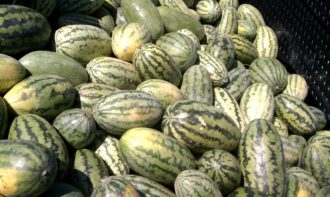ATHENS, Georgia – Some species of naturally occurring bacteria, when applied to the flowers of watermelon plants, can reduce the spread of bacterial fruit blotch – a cucurbit disease that causes fruit rot and economic losses.
The technique of applying bacteria to the stigmas of female flowers to slow the spread of bacterial fruit blotch from seed to seedling can serve as a biocontrol method for managing the disease, said Safira Sutton, a graduate student at the University of Georgia who conducted the Southern Sustainable Agriculture Research & Education (SSARE)-funded study.
The goal behind the study (GS14-139), “A Novel Technique for Treating Seeds with Biocontrol Agents for the Sustainable Management of Bacterial Fruit Blotch of Watermelon,” was to disrupt the “pistil invasion pathway” of the disease’s causal bacterial agent, Acidovorax citrulli. Previous research showed that the bacterium can infect watermelon seeds by penetrating the pistil of the female flower and localizing in the seed endosperm.
“Infested cucurbit seeds are the primary source of inoculum for bacterial fruit blotch outbreaks that develop in seedling transplant facilities and fruit production fields. Currently there are no commercially available sources of bacterial fruit blotch resistance, and management relies heavily on foliar-applied chemicals,” said Sutton. “By exploiting this pistil invasion pathway, we hypothesized that biocontrol agents would be more effective in limiting bacterial fruit blotch seedling transmission.”
In the study Sutton and plant pathologist Ron Walcott screened 300 bacteria and selected three strains of Bacillus species based on their ability to reduce bacterial fruit blotch seed-to-seedling transmission when applied as a seed treatment.
A watermelon field plot was established at the Blackshank Farm in Tifton, GA. At anthesis, female watermelon flowers were hand pollinated and the stigmas were inoculated separately with the three bacteria strains. The flowers were allowed to develop into mature fruit. After harvest, fruits were stored and the seeds were extracted to determine the percent incidence of bacterial fruit blotch.
In the control, a saline solution, watermelon seeds had a bacterial fruit blotch seedling transmission rate of nearly 80 percent. By comparison, the watermelon flowers treated with the Bacillus species had mean bacterial fruit blotch seedling transmission percentages of 19, 53 and 42 percent.
“This data suggests great potential for flower treatments with biocontrol agents to aid the management of bacterial fruit blotch,” said Sutton. “Results of this study provide an environmentally sound and sustainable approach for managing seed-borne plant diseases that may be of potential use for seed companies.”
The researchers indicated that the method could be incorporated with other sustainable management practices as part of an overall integrated disease management program.
--30--
Published by the Southern Region of the Sustainable Agriculture Research and Education (SARE) program. Funded by the USDA National Institute of Food and Agriculture (NIFA), Southern SARE operates under cooperative agreements with the University of Georgia, Fort Valley State University, and the Kerr Center for Sustainable Agriculture to offer competitive grants to advance sustainable agriculture in America's Southern region. This material is based upon work that is supported by the National Institute of Food and Agriculture, U.S. Department of Agriculture, through Southern Sustainable Agriculture Research and Education, under sub-award number: GS14-139. USDA is an equal opportunity employer and service provider. Any opinions, findings, conclusions, or recommendations expressed in this publication are those of the author(s) and do not necessarily reflect the view of the U.S. Department of Agriculture.
